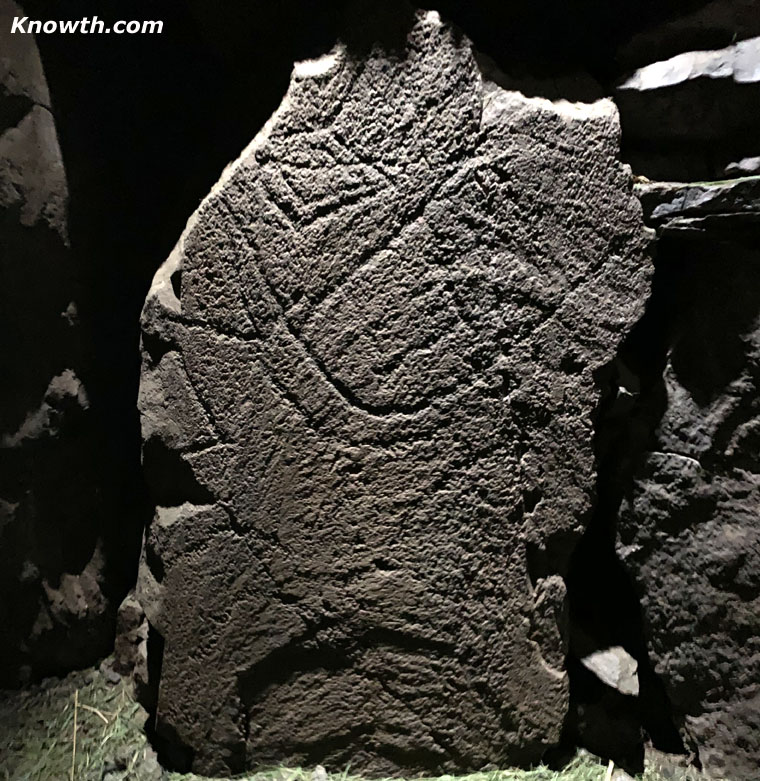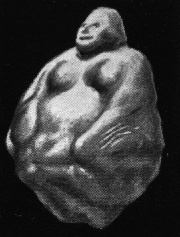Fourknocks Face Stone | Possible Figurative Art

Fourknocks Face Stone | Possibily anthropomorphic (representing a human form)
P.J. Hartnet the archaeologist who excavated Fourknocks in 1950 had no doubt about classifing the Face Stone as anthropomorphic (representing a human form). The following description is from his excavation report.
This, one of the functional uprights of the central chamber, measures 1 meter in height and 50cm in breadth. It is a coarse-grained sandstone, the decorated surface ground smooth and regular. The ornament is executed in broad, U-sectioned channels achieved by the fusing of the isolated peckings by subsequent hammering. That this remarkable design portrays a caricature like figure which belongs within the anthropomorphic group of "statue-menhirs" is unquestionable. It is, perhaps, worth noting that the workmen on the excavation were among the first to appreciate its " human" characteristics and referred to it as "The Clown," or "The Old Man of Fourknocks," and sometimes as "King Tut".
Though it bears a vague likeness to the statue-menhirs of Brittany, no exact parallel can be cited for it. The composition is a unitary one and depicts the head and upper part of the body, contained in a rough border formed by a vertical zig-zag on the left (as viewed), a curved double line on the right and by a single line across the lower part. The right "eye" (on the left as viewed) is indicated by a double lozenge, the other by a much-worn or sunken single lozenge.
A single lozenge marks the "nose" and the ends of this lozenge continued beyond the apex may possibly represent "eyebrow " and/or "hair" motifs. The "mouth" is suggested by two dependent arcs forming a wide crescentic curve. Other features suggested are a possible "belt" (a double line midway between the "mouth" and the bottom of the frame), and a rather indefinite loop or curve above this on the right, a hand"?
The phenomenon of seeing faces in everyday objects
In a presentation given at Fourknocks in June 2004, Martin Dire argued that the Face Stone is unlikely to depict an anthropomorphic figure. The literature also states that Fourknocks contains one of the earliest representations of the human
face. When dealing with a culture as clearly sophisticated as is evident from the careful positioning of the massive stones, it is unlikely that they
produced a crude face when clearly they could manage much more difficult tasks. It is more likely that modern day interpreters
of the site have seen faces where there are none.
The literature also states that Fourknocks contains one of the earliest representations of the human
face. When dealing with a culture as clearly sophisticated as is evident from the careful positioning of the massive stones, it is unlikely that they
produced a crude face when clearly they could manage much more difficult tasks. It is more likely that modern day interpreters
of the site have seen faces where there are none.
There is a curious tendency for the human mind to see faces in clouds, melting snow, embers of fires etc. and there is a scientific reason behind such a phenomenon, most likely based on the primitive need to identify human from nonhuman. Depictions of the human form do exist from the stone age, notably the "Grimes Graves Goddess" from Norfolk. (Image from a booklet "Grime's Graves, Norfolk", published in 1975)
Boyne Valley Private Day Tour
 Immerse yourself in the rich heritage and culture of the Boyne Valley with our full-day private tours.
Visit Newgrange World Heritage site, explore the Hill of Slane, where Saint Patrick famously lit the Paschal fire.
Discover the Hill of Tara, the ancient seat of power for the High Kings of Ireland.
Book Now
Immerse yourself in the rich heritage and culture of the Boyne Valley with our full-day private tours.
Visit Newgrange World Heritage site, explore the Hill of Slane, where Saint Patrick famously lit the Paschal fire.
Discover the Hill of Tara, the ancient seat of power for the High Kings of Ireland.
Book Now
Home
| Newgrange
| Knowth
| Dowth
| Hill of Tara
| Fourknocks
| Loughcrew
| More Places
| Labyrinths
| Local Info
| Art Works
| Articles
| Images
| Books
| Links
| Boyne Valley Tours
| Contact
